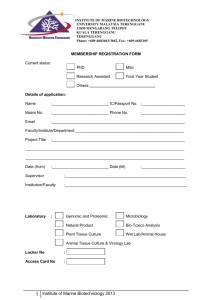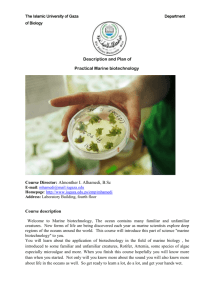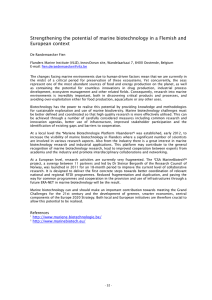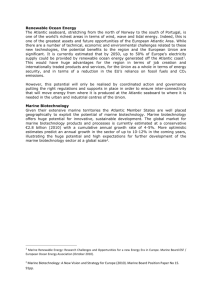SOCIAL SCIENCE INFORMED SUPPORT SYSTEMS TO BETTER
advertisement
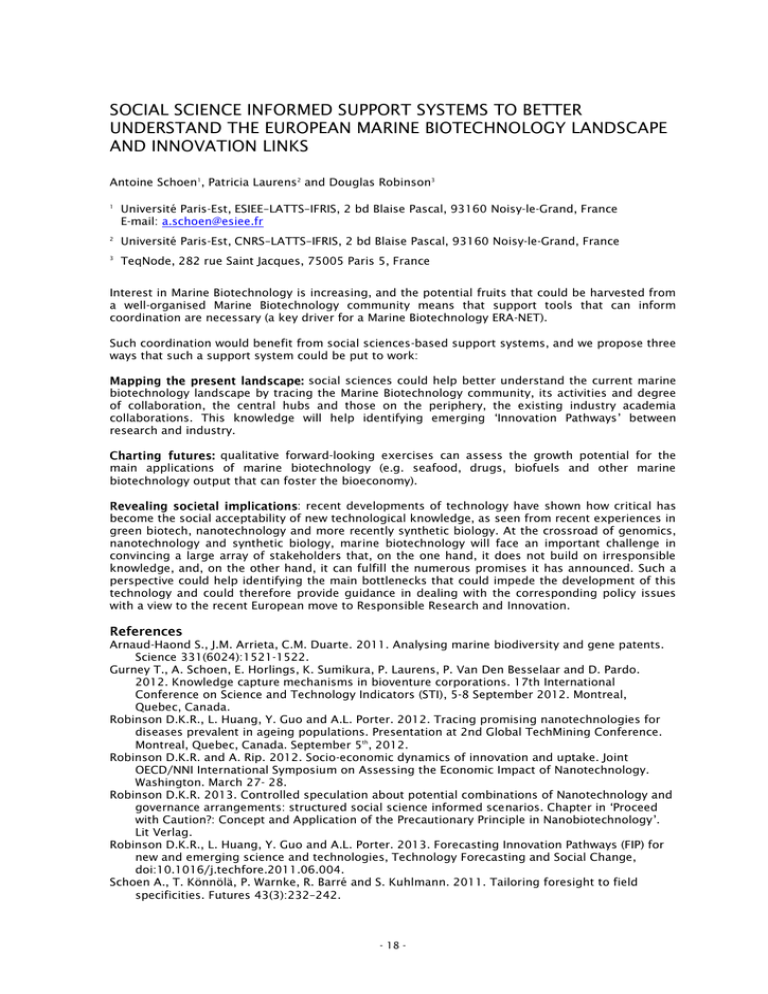
SOCIAL SCIENCE INFORMED SUPPORT SYSTEMS TO BETTER UNDERSTAND THE EUROPEAN MARINE BIOTECHNOLOGY LANDSCAPE AND INNOVATION LINKS Antoine Schoen1, Patricia Laurens2 and Douglas Robinson3 1 Université Paris-Est, ESIEE–LATTS–IFRIS, 2 bd Blaise Pascal, 93160 Noisy-le-Grand, France E-mail: a.schoen@esiee.fr 2 Université Paris-Est, CNRS–LATTS–IFRIS, 2 bd Blaise Pascal, 93160 Noisy-le-Grand, France 3 TeqNode, 282 rue Saint Jacques, 75005 Paris 5, France Interest in Marine Biotechnology is increasing, and the potential fruits that could be harvested from a well-organised Marine Biotechnology community means that support tools that can inform coordination are necessary (a key driver for a Marine Biotechnology ERA-NET). Such coordination would benefit from social sciences-based support systems, and we propose three ways that such a support system could be put to work: social sciences could help better understand the current marine biotechnology landscape by tracing the Marine Biotechnology community, its activities and degree of collaboration, the central hubs and those on the periphery, the existing industry academia collaborations. This knowledge will help identifying emerging ‘Innovation Pathways’ between research and industry. qualitative forward-looking exercises can assess the growth potential for the main applications of marine biotechnology (e.g. seafood, drugs, biofuels and other marine biotechnology output that can foster the bioeconomy). : recent developments of technology have shown how critical has become the social acceptability of new technological knowledge, as seen from recent experiences in green biotech, nanotechnology and more recently synthetic biology. At the crossroad of genomics, nanotechnology and synthetic biology, marine biotechnology will face an important challenge in convincing a large array of stakeholders that, on the one hand, it does not build on irresponsible knowledge, and, on the other hand, it can fulfill the numerous promises it has announced. Such a perspective could help identifying the main bottlenecks that could impede the development of this technology and could therefore provide guidance in dealing with the corresponding policy issues with a view to the recent European move to Responsible Research and Innovation. Arnaud-Haond S., J.M. Arrieta, C.M. Duarte. 2011. Analysing marine biodiversity and gene patents. Science 331(6024):1521-1522. Gurney T., A. Schoen, E. Horlings, K. Sumikura, P. Laurens, P. Van Den Besselaar and D. Pardo. 2012. Knowledge capture mechanisms in bioventure corporations. 17th International Conference on Science and Technology Indicators (STI), 5-8 September 2012. Montreal, Quebec, Canada. Robinson D.K.R., L. Huang, Y. Guo and A.L. Porter. 2012. Tracing promising nanotechnologies for diseases prevalent in ageing populations. Presentation at 2nd Global TechMining Conference. Montreal, Quebec, Canada. September 5th, 2012. Robinson D.K.R. and A. Rip. 2012. Socio-economic dynamics of innovation and uptake. Joint OECD/NNI International Symposium on Assessing the Economic Impact of Nanotechnology. Washington. March 27- 28. Robinson D.K.R. 2013. Controlled speculation about potential combinations of Nanotechnology and governance arrangements: structured social science informed scenarios. Chapter in ‘Proceed with Caution?: Concept and Application of the Precautionary Principle in Nanobiotechnology’. Lit Verlag. Robinson D.K.R., L. Huang, Y. Guo and A.L. Porter. 2013. Forecasting Innovation Pathways (FIP) for new and emerging science and technologies, Technology Forecasting and Social Change, doi:10.1016/j.techfore.2011.06.004. Schoen A., T. Könnölä, P. Warnke, R. Barré and S. Kuhlmann. 2011. Tailoring foresight to field specificities. Futures 43(3):232–242. - 18 -
